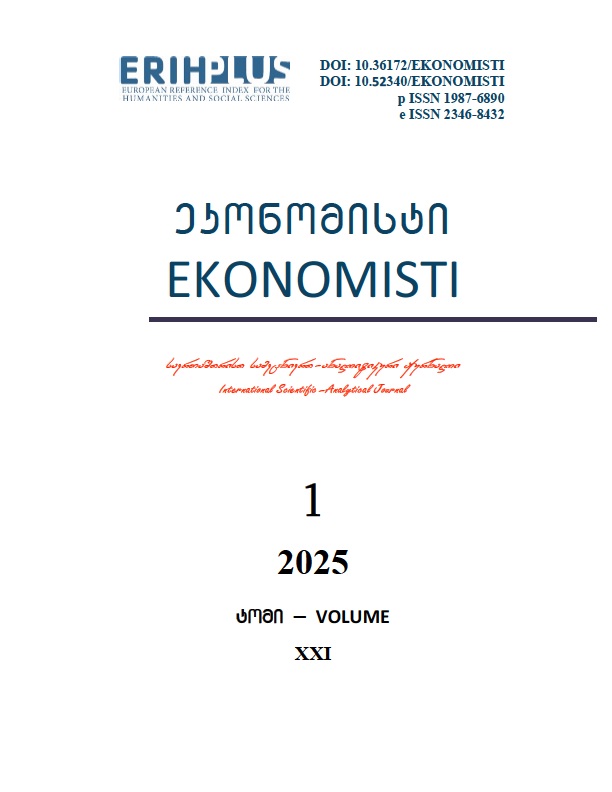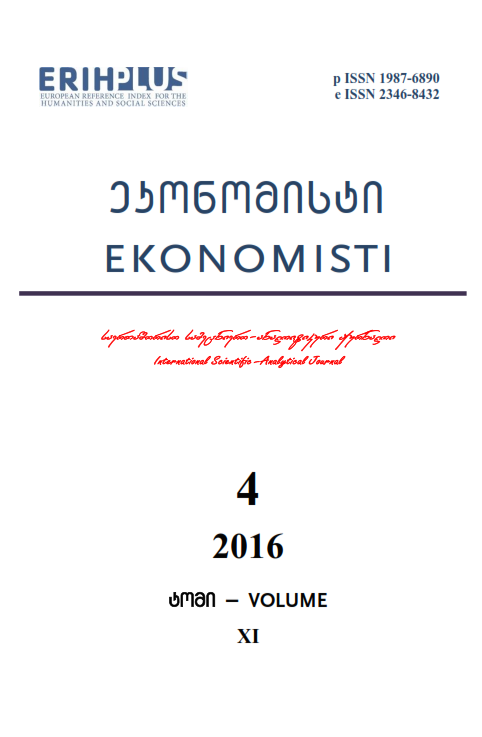
The international scientific and analytical, reviewed, printing and electronic journal of Paata Gugushvili Institute of Economics of Ivane Javakhishvili Tbilisi State University

ESSENTIALS OF ECONOMIC FREEDOM AND ITS INFLUENCE ON ECONOMIC DEVELOPMENT (EMPIRICAL STUDY ON THE CASE OF GEORGIA)
Summary
In this paper, we will investigate the most essential ingredients for strengthening and developing economically free environment. There is shown a systemic link between economic freedom and economic growth on the case of Georgia. Our empirical results, based on different econometric modelling techniques reveal positive relation between economic freedom and real GDP growth.
Key Words: Economic Freedom, GDP Growth, Private Property, Corruption, Fiscal Health.
Introduction - The Concept of Economic Freedom
For to be free is not merely to cast off one’s chains, but to live in a way that respects and enhances the freedom of others - Nelson Mandela (Long Walk to Freedom)
Freedom is equally necessary condition for success in life, society and business. It is one of the basic needs of every individual and has a key role for human, social, economic and political development. In its broad understanding, freedom means the existence of choices. When we are forced to do things or not to do, we don’t have that many choices and are not allowed to make our own decisions. Economic freedom empowers individuals giving them more options and choices. The only prerequisite of their success/fail is their personal effort and ability.
There is no official definition to economic freedom, however, most economists (and not only) agree that economic freedom includes the freedom to choose and supply resources, high competition level in all sectors of economy, the right to trade freely and the right to secure legally obtained property by invasions of any other side.
The report of Heritage Foundation (2004 p. 50) describes economic freedom as: “… the absence of government coercion or constraint on the production, distribution, or consumption of goods and services beyond the extent necessary for citizens to protect and maintain liberty itself.”
Economic freedom is the fundamental right of every individual to utilize their own “human resources” the way they fit. The most essential aspects of economic freedom are personal choice, voluntary exchange, freedom to compete and protection of individuals and private property.
People are often confused to separate economic freedom from political and civil liberties. Political liberty means that citizens are free to vote, lobby and choose among candidates, elections are competitive and fair, while civil liberty encompasses freedom of the press and the rights of individuals to assemble or hold alternative religious views and etc. [Gwartney and Lawson 2003, 405-409]
For gaining high levels of freedom (individual, political, economic etc.) governmental institutions should not discriminate either or in favor of people unrelated to individual merit, government decision making must be characterized by openness and transparency and the resource allocation should be based on the free market incentives (open competition).
Another important issue is to define the role of government in this layout. Generally, state action or government control that interferes with individual autonomy limits economic freedom, but the goal should not be simply an absence of government coercion. Government must do something that the market cannot do for itself, namely, to determine, arbitrate and enforce the rules of the “game”.
It is important to distinguish the day-to-day activities of people from the general customary and legal framework. The day-to-day activities are like the actions of participants in a game when they are playing it and the framework - the rules of the game they play. And just as a good game requires acceptance of the rules by participants and an umpire to interpret and enforce them, so a good society requires that its members agree on the general terms and conditions. The need for government arises in these respects.
Body of Paper - Key Ingredients of Economic Freedom
There may be discussed many factors (economic and non-economic) which can influence on an overall level of economic freedom. As it was mentioned above the most essential aspects of economic freedom are personal choice, voluntary exchange, freedom to compete and protection of individuals and private property.
Generally, one can be considered as an economically free when 1) he/she has many choices 2) his/her personal choice does not violate the identical rights of others, namely, do not discriminate other people’s choices. Everything foreword is based on this principle. Let’s discuss key elements for gaining, improving and developing economic freedom.
Property Rights – can be considered as the basic ingredient for economic freedom. This element assesses the extent to which a country’s legal framework allows individuals to freely accumulate private property, secured by clear laws that are enforced effectively by the government. Mostly, it provides quantifiable measure of the degree to which a country’s laws protect private property rights. We have to consider physical and intellectual property rights under this element.
Judicial Effectiveness – In its narrower sense, justice is fairness. It is something that must protect the rights of citizens against any unlawful acts by others whether it is government or any other part of the society. First of all, it requires efficient judicial systems, which are fair and ensure that laws are fully respected. A fair and independent judicial branch is one of the essentials for democratic system. It requires not only freedom for judges to make case decisions without influence, but also recognition of the judicial branch as a co-equal branch of government responsible for governing itself and accountable to the public.
Transparency – We can define transparency as increased flow of timely and reliable economic, social and political information which is accessible to all relevant stakeholders. It is a multifaceted concept that is often conflated with accountability, corruption, impartiality and rule of law. Economic and institutional transparency is about e-government, access to information laws, transparency in budget process, transparency of policy and transparency of public sector. Generally, openness can drive effectiveness, as involving more people can bring greater insight, avoid arrogance and defective decision making. Transparency and openness raises accountability, giving parliament, the press and the public tools to hold government to account.
Corruption – in many different papers we can find that corruption reduces economic performance. Still, some people consider corruption as a way to overcome cumbersome bureaucratic constraints, inefficient provision of public services and rigid laws, especially when governmental institutions are weak and show too weak performance. It can affect output positively in a short run period in very exceptional cases. Despite of above mentioned, it’s widely recognized that corruption hinders economic growth in a long term period. The most dangerous issue is that it can affect resource misallocation when decisions on how public funds will be misallocated follows from the possibility that a corrupt decision-maker will consider potential corruption payments as one of the decision criteria. [Pieroni and d'Agostino 2013, 54-59]
Fiscal Performance – The main source for any of the government to generate revenues is a sound tax policy. Shifting tax burden can clearly describe economic reaction to applied changes as it will cause changes in prices and output.[1]
We can easily show how taxes affect outputs, let’s look at the main macroeconomic model for GDP:
Y = C + I + G + NX
Where Y - is output, C - is consumption, G - is government expenditures and NX - is net exports. Different studies show that consumption typically takes the biggest part in GDP. If we lower the taxes, it will in turn raise disposable incomes of people, allowing the consumer to spend additional sums, thereby, increasing GDP. Reducing taxes will push the aggregate demand as consumers demand more goods and services with their higher disposable incomes. On the other hand, supply side tax cuts are aimed to stimulate capital formation. To summarize above mentioned, it is a common belief that reducing marginal tax rates would spur economic growth, the idea is that lower tax rates will give people more after-tax income that could be used to buy more goods and services.
Other confusing issue discussing country’s fiscal performance is Government Spending. There can be discussed not so few circumstances in which lower levels of government spending would enhance economic growth or higher levels of government spending would be more desirable. Presumably, if government spending is zero and there is no government at all, there would be very little economic growth because enforcing contracts, protecting property and developing an infrastructure would be very difficult. In other words, some government spending is necessary for successful operation of the rule of law.
Open Markets – one of the most important factors to reach high levels of economic freedom is a Free Market. Mainly, it includes three important sub-factors: a) trade freedom, b) investment freedom, c) financial freedom.
Even today, we often hear that markets must be controlled to avoid economic disparity and unfair outcomes. It’s clear that free market is the most frightening thing for politicians just because at its roots they cannot control it. In a true free market, buyers and sellers conduct their businesses without any government regulation, but there is continuing debate among politicians and economists about how much government regulation is necessary in the economy. Those who are in charge of less regulation argue that removing restrictions (free market) will force businesses to protect consumers providing superior products and services and creating affordable prices for everyone. [Rode 2012, 95-100].
Economic Freedom and Economic Development - Empirical Study on the Case of Georgia
Adam Smith, Douglass North, Arthur Lewis, John Stuart Mill, Frederic Bastiat, this is an incomplete list of all-time greatest economists who argued that perfection of markets are the most important for economic prosperity and growth. Classical approach in economics highlights that the presence and perfection of markets increases competition and efficiency.[2]
In this chapter we will show how economic freedom raises living standards and improves economic development. Firstly, we will build a model to show how economic freedom affects economic growth.
Empirical study is based on the case of Georgia. Data used in the study covers 1995 - 2016 period. It consists of five different variables and is collected from three main sources. The first variable is Economic Freedom Index Rate (by Heritage Foundation), which is collected from the official web page of the Heritage Foundation. Real GDP, Inflation Rate, Budget Deficit and Expenditures on Education are collected from the official web page of National Bank of Georgia and National Statistics Office of Georgia (See Table I).
Table I
|
Year |
Overall Index |
Budget Deficit/Real GDP |
Real GDP |
Real Expenditures on Education |
Inflation Rate |
|
1996 1997 1998 1999 2000 2001 2002 2003 2004 2005 2006 2007 2008 2009 2010 2011 2012 2013 2014 2015 2016 |
44.1 46.5 47.9 52.5 54.3 58.3 56.7 58.6 58.9 57.1 64.5 69.3 69.2 69.8 70.4 70.4 59.4 72.2 72.6 73.0 76.0 |
-0.067 -0.080 -0.062 -0.071 -0.030 -0.015 -0.018 -0.018 -0.003 -0.026 -0.034 -0.048 -0.062 -0.092 -0.066 -0.036 -0.035 -0.028 -0.022 -0.020 -0.021* |
5334.440 5895.57 6078.624 6253.035 6367.988 6673.998 7039.322 7817.737 8275.648 9070.081 9921.170 11169.21 11461.09 11032.28 11716.40 12558.28 13362.07 13805.69 14443.97 14844.78 15211.21* |
2.695 2.950 2.950 3.450 3.765 3.822 3.927 3.457 3.828 3.745 4.243 3.759 4.063 4.872 4.852 5.006 4.854 5.153 5.085 4.894 5.054 |
0.394 0.071 0.036 0.192 0.040 0.047 0.056 0.048 0.057 0.082 0.092 0.092 0.100 0.017 0.071 0.085 -0.009 -0.005 0.031 0.040 0.021 |
Sources: www.nbg.gov.ge; www.geostat.ge; www.heritage.org.
For better analytical understanding and presentational clarity let’s briefly discuss the basics (Dawson 2010) of economic freedom index calculated by Heritage Foundation. Index focuses on four key aspects of economic environment which are divided into 12 different components (See Table II). Each of them is graded on a scale from 0 to 100. Results of these 12 components of economic freedom, which are calculated from a number of sub-variables are equally weighted and averaged to produce an overall economic freedom score for each economy. After having the final scores for each country, they are classified into five categories of economic freedom: Free, Mostly Free, Moderately Free, Mostly Unfree and repressed.
Table II
|
Rule of Law |
Property Rights |
|
Judicial Effectiveness |
|
|
Government Integrity |
|
|
Government Size |
Tax Burden |
|
Government Spending |
|
|
Fiscal Health |
|
|
Regulatory Efficiency |
Business Freedom |
|
Labor Freedom |
|
|
Monetary Freedom |
|
|
Market Openness |
Trade Freedom |
|
Investment Freedom |
|
|
Financial Freedom |
After a brief review of the index, we can move on to our model which shows the effect of economic freedom on log of Real GDP by using an overall index score and other variables.[3] The log of Real GDP simplifies the interpretation of the model as it will allow us to see the percentage effects of each independent variable on real GDP.
Real GDP is the dependent variable in our model, while explanatory variables are logarithm of an overall index, expenditures on education to GDP ratio and lagged variable.
To analyze the influence of economic freedom index on economic growth it will be used an Error Correction Model (ECM). We assume that the factors which have some influence on GDP in a long run period are an Overall Index of Economic Freedom and Real Expenditures on Education.
Model 1 is as follows:
![]()
Model 1
Where log(RealGDP) is the natural logarithm of the real GDP, Index is an overall index of economic freedom, ExpOnEduc is real expenditures on education and εt is an error term.[4]
If we accept the intuition underlying the basic macroeconomic model for GDP, then it’s expected that any components of the Model 1 what are likely to increase outputs (consumption, investments, government spending, net exports) would have a positive relation to real GDP, so an overall economic freedom index is expected to have a positive relation on GDP, as well as the level of education. [Doucouliagos and Ulubasoglu 2005, 60-64]
Let’s estimate model 1 and analyze the results (see the detailed estimation in Appendix 1)
Estimated model 1 is as follows:
![]()
![]()
Model 2
Estimated Model 1 showed high explanatory power, as R2 equals to .9617, meaning that approximately 96.17 percent of the sample variation in real GDP is explained by independent variables.
When there is a correlation between any variables in a long run period, we have to examine whether these results are sustainable or not. Sustainable link between correlated variables means that if the long run equilibrium breaks down, correlated variables should return to the status quo independently (if the correlation level is strong enough). Long term factors are not supposed to have short term impacts, so for short term dynamics we have to use other variables which are not having any effects in the long run period. We assume that such factors are inflation and fiscal deficit over GDP.
In the new model 3 a dependent variable is differential of the logarithm of GDP (percentage change) and explanatory variables are: change in an overall economic freedom index, inflation, fiscal deficit over GDP and structural shocks of the model 2.
Hence, a new model is as follows:
![]()
Model 3
Estimation of the Model 3 with Ordinary Least Square (OLS) method leads us to the following results (see detailed estimation in Appendix 2):
![]()
Model 4
Differential of economic freedom index equaled to .006 what proves statistically significant positive impact of the overall index on GDP growth.
The most important finding in the Model 4 is the meaning of coefficient of Residual (-1) = -0.27, it proves the main objective about sustainability of a long run model: every next year, model compensates deviation from long run equilibrium in the previews year by 27%.
Apart from our empirical study, it would be interesting to generalize our intuition about economic freedom and its positive relation on economic growth on the different countries. For this purpose we will take top five countries from each category of economic freedom and average their GDP per capita (See Figure I).
Figure I
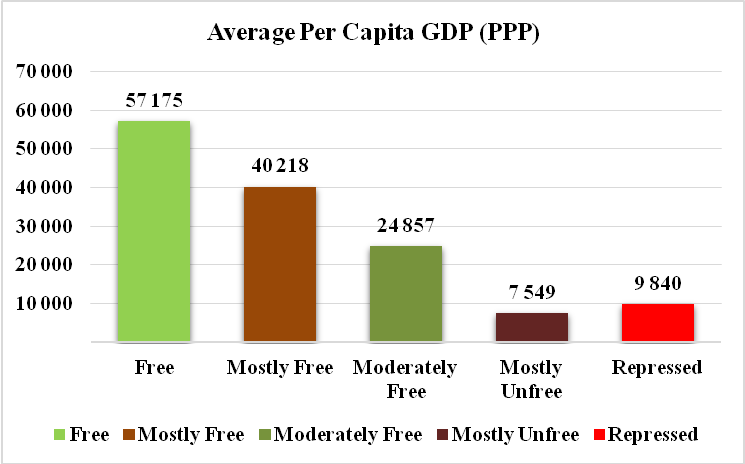
Sources: http://data.worldbank.org/; www.heritage.org
Countries that allow their citizens more economic freedom show higher incomes and better living standards. Achieving greater overall prosperity is equally important to every single country as it diminishes the global poverty rate.
Conclusions
The identification of the most important ingredients of economic freedom is one of the essentials of any country’s economic policy. Precisely defined key aspects of economic freedom are considered as significant pre conditions to develop and strengthen rationally free economic environment. In today’s reality absolute freedom does not (and cannot) exist, but it should not make policymakers feel sceptic about it. Moreover, it should be considered as one of the biggest challenges of a modern world, so that every country must try its best to spread freedom.
Nowadays, one of the most enduring questions in economics is what causes economies to grow? Liberals find that free markets and a minimal government presence in the economy can lead to prosperity, in other words economic freedom leads to economic growth.
Our empirical study on the case of Georgia is a bright example how economic freedom influences economic growth. It proved the sense about sustainable correlation between freedom and growth in a long term. Model 4 clearly defined that, if in the period t, there are any shocks causing disequilibrium, in the period t+1 (ceteris paribus), they will be reduced by 0.26, in the period t+2, to 0.262 and it gradually disappears.
We have to mention that differential of the overall index (in Model 4) showed positive impact on GDP growth but education did not. This was expected due to several reasons. As it was mentioned above, an overall index consolidates 12 different components which influence different macroeconomic parameters. For instance the components which are gathered in the MARKET OPENESS category (trade freedom, investment freedom, financial freedom) are expected to have short and midterm impacts on GDP, so as soon as the level of economic freedom goes down, firms immediately reduce investments, households start to save etc.
For every country it is necessary to define both strategy and the goals of its economic policy so that economic freedom could bring sustainable economic development. This should facilitate the creation of a free economic environment, otherwise, the desired economic freedom will show up only in different worldwide ratings and won’t bring expected fruits, and in other words freedom will turn just into “pseudo-freedom.”
Appendix 1
Tabele 1
|
Dependent Variable: LOG(GDP) |
|
|
||
|
Method: Least Squares |
|
|
||
|
Date: 06/16/16 Time: 17:01 |
|
|
||
|
Sample (adjusted): 1996 2015 |
|
|
||
|
Included observations: 20 after adjustments |
|
|||
|
|
|
|
|
|
|
|
|
|
|
|
|
Variable |
Coefficient |
Std. Error |
t-Statistic |
Prob. |
|
|
|
|
|
|
|
|
|
|
|
|
|
C |
7.743837 |
0.181708 |
42.61681 |
0.0000 |
|
Index |
0.019157 |
0.004100 |
3.916851 |
0.0011 |
|
ExpOnEduc |
0.000943 |
0.000193 |
4.835743 |
0.0002 |
|
|
|
|
|
|
|
|
|
|
|
|
|
R-squared |
0.961749 |
Mean dependent var |
9.122073 |
|
|
Adjusted R-squared |
0.956308 |
S.D. dependent var |
0.338706 |
|
|
S.E. of regression |
0.061241 |
Akaike info criterion |
-2.610516 |
|
|
Sum squared resid |
0.063758 |
Schwarz criterion |
-2.461156 |
|
|
Log likelihood |
29.10516 |
Hannan-Quinn criter. |
-2.581360 |
|
|
F-statistic |
282.0915 |
Durbin-Watson stat |
1.034934 |
|
|
Prob(F-statistic) |
0.000000 |
|
|
|
|
|
|
|
|
|
|
|
|
|
|
|
Correlogram Q statistics show that there is first order autocorrelation in the estimated model 2.[5] Failure to reject null hypothesis that the model is homoscedastic indicated that model 2 is homoscedastic.[6]
Table 2:
|
Heteroskedasticity Test: Breusch-Pagan-Godfrey |
||||
|
|
|
|
|
|
|
|
|
|
|
|
|
F-statistic |
1.177323 |
Prob. F(2,17) |
0.3320 |
|
|
Obs*R-squared |
2.433158 |
Prob. Chi-Square(2) |
0.2962 |
|
|
Scaled explained SS |
1.732341 |
Prob. Chi-Square(2) |
0.4206 |
|
|
|
|
|
|
|
|
|
|
|
|
|
Also Jarque-Bera test showed failure to reject null hypothesis the estimated model 2 is normal, what means that residuals describing structural shocks of our model is normal.
Figure I
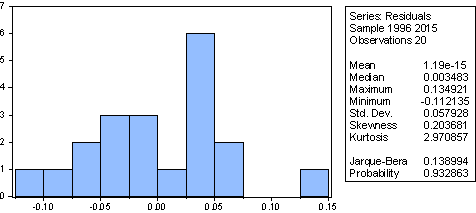
Appendix 2
Table I
|
Dependent Variable: DLOG(GDP) |
|
|
||
|
Method: Least Squares |
|
|
||
|
Date: 06/16/16 Time: 17:29 |
|
|
||
|
Sample (adjusted): 1998 2015 |
|
|
||
|
Included observations: 18 after adjustments |
|
|||
|
|
|
|
|
|
|
|
|
|
|
|
|
Variable |
Coefficient |
Std. Error |
t-Statistic |
Prob. |
|
|
|
|
|
|
|
|
|
|
|
|
|
RESID01(-1) |
-0.269507 |
0.124104 |
-2.171617 |
0.0476 |
|
D(OVERALL_SCORE) |
0.006017 |
0.003282 |
1.833558 |
0.0881 |
|
0.380348 |
0.120698 |
3.151241 |
0.0071 |
|
|
Bud. Def. |
0.866515 |
0.192988 |
4.489989 |
0.0005 |
|
|
|
|
|
|
|
|
|
|
|
|
|
R-squared |
0.478867 |
Mean dependent var |
0.051303 |
|
|
Adjusted R-squared |
0.367195 |
S.D. dependent var |
0.036561 |
|
|
S.E. of regression |
0.029084 |
Akaike info criterion |
-4.044142 |
|
|
Sum squared resid |
0.011842 |
Schwarz criterion |
-3.846282 |
|
|
Log likelihood |
40.39728 |
Hannan-Quinn criter. |
-4.016860 |
|
|
Durbin-Watson stat |
2.106967 |
|
|
|
|
|
|
|
|
|
|
|
|
|
|
|
Correlogram - Q-statistics show that there is no autocorrelation in the Model 4. I tested the null hypothesis the model is homoscedastic. A failure to reject null hypothesis indicated that Model 4 is homoscedastic.
Table 2
|
Heteroskedasticity Test: Breusch-Pagan-Godfrey |
||||
|
|
|
|
|
|
|
|
|
|
|
|
|
F-statistic |
0.786272 |
Prob. F(4,13) |
0.5542 |
|
|
Obs*R-squared |
3.506428 |
Prob. Chi-Square(4) |
0.4769 |
|
|
Scaled explained SS |
1.651775 |
Prob. Chi-Square(4) |
0.7995 |
|
|
|
|
|
|
|
|
|
|
|
|
|
Histogram normality test showed failure to reject null hypothesis the model is normal, what means that our model is normal.
Figure I
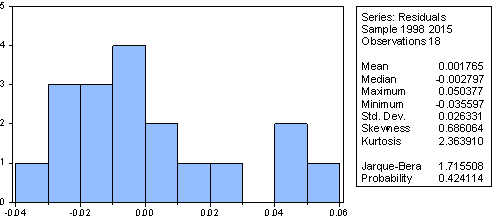
References
- Bjornskov, Christian. "Economic freedom and economic crises." European Journal of Political Economy, 2016: 11-23.
- Carlsson, Frederik , and Susanna Lundstrom. "Economic Freedom and Growth: Decomposing the Effects." Public Choice, Vol 112, No. 3/4, 2002: 335-344.
- Cebula, Richard J., J.R. Clark, and Franklin G. Mixon. "The Impact of Economic Freedom on Per Capita Real GDP: A study of OECD Nations." The Journal of Regional Analysis & Policy, 2013: 34-41.
- Dawson, J. Macroeconomic volatility and economic freedom - a preliminary analysis pp. 175-185. Vancouver: The Fraser Institute, 2010.
- Doucouliagos, Chris, and Mehmet Ali Ulubasoglu. "Economic Freedom and economic growth: Does Specification make a difference?" European Journal of Political Economy, 2005: 60-81.
- Farhadi, Minoo, Rabiul MD Islam, and Solmaz Moslehi. "Economic freedom and productivity growth in resource-rich economies." World Development, 2015: 109-126.
- Gwartney, James, and Robert Lawson. "The concept and measurement of economic freedom." European Journal of Political Economy, 2003: 405-430.
- Holcombe, R.G. "Make economics policy relevant. Depose the omniscient benevolent dictator." The Independent Review, 2012: 165-176.
- Kurz , Mordecai, Hehui Jin, and Maurizio Motolese. The Role of Expectations in Economic Fluctuations and Efficacy of Monetary Policy. Stanford: Department of Economics, Stanford University Press, 2004.
- National Bank of Georgia. 06 15, 2016. https://www.nbg.gov.ge/index.php?m=304.
- National Statistics Department of Georgia. 06 15, 2016. http://www.geostat.ge/index.php?action=page&p_id=374&lang=eng.
- Parker, Jeffrey, and Aviel Nagel. Empirical Macroeconomics: The Effects of Monetary Policy. Portland, Oregon.: Department of Economics, Reed College, 2003.
- Pieroni, L, and G d'Agostino. "Corruption and the effects of economic freedom." European Journal of Political Economy, 2013: 54-72.
- Rode, M., Coll, S. "Economic freedom and growth. Which policies matter the most?" Constitutional Political Economy, 2012: 95-133.
- The Heritage Foundation. 06 15, 2016. http://www.heritage.org/index/explore.
- Walsh, Carl Eugene. Monetary Theory and Policy. Massachusetts: Massachusetts Institute of Technology, 2010.
- 17. Wooldridge, Jeffrey M. Introductury Econometrics: Modern Approach. 4th Edition. Mason, OH: South-Western Cengage Learning, 2009.
[1] If a tax is levied on a non-price sensitive good or service (e.g. bread, cigarettes etc.) it would not lead to big changes such as for example unemployment growth.
[2] Classical economics is a broad term that refers to the dominant economic paradigm of the 18th and 19th centuries. Adam Smith is considered the progenitor of classical theory. Other important contributors are David Ricardo, Thomas Malthus, Jean Baptiste Say and others.
[3] Model is built on the case of Georgia.
[4] There should be some combinations of structural innovations, such as ARMA process.
[5] It is caused by stationary AR(1) error term.
[6] Heteroscedascisity (also spelled heteroskedasticity) refers to the circumstance in which the variability of a variable is unequal across the range of values of a second variable that predicts it.
